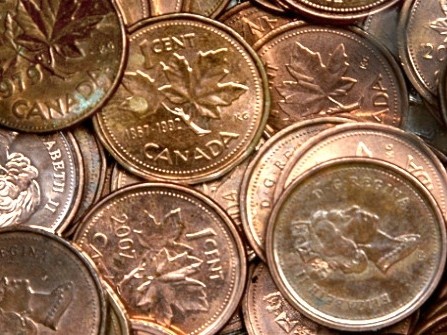
 It was three years ago that the Royal Canadian Mint stopped distributing the Canadian penny, nearly a year after it had ceased their production, in May of 2012. So how is Canada doing without the penny?
It was three years ago that the Royal Canadian Mint stopped distributing the Canadian penny, nearly a year after it had ceased their production, in May of 2012. So how is Canada doing without the penny?
The decision marked the end of a century-and-a-half of the penny’s employ. When the coin was first introduced, there was a good reason. Its purchasing power would buy the equivalent of twenty cents of goods today. But near the end there was virtually nothing a penny could buy.
“Pennies take up too much space on our dressers at home,” said then finance minister Jim Flaherty, flatly. “We will, therefore, stop making them.”
Just a few years on, you hardly ever see a penny, despite the fact that Canada produced more than 800-million of them each year. That’s about 24 pennies per person, for the math challenged.
Three years, it seems, is enough time to ask the question: was it worth it?
From a taxpayer perspective, the answer is a tepid yes. The RCM estimates that the move saves Canadian taxpayers $11-million a year. It says the country benefits from removing the handling costs the coin imposed on retailers and from financial institutions and from the environmental impact of the penny, which was comprised mostly of steel, with a little nickel and copper thrown in. There’s also the matter that it cost about 1.6 cents to produce one cent. That’s bad math from anyone’s perspective.
May 2012: Canada eliminates penny. Anyone missing it? Not really…
Canada wasn’t the first to ban the penny; Israel, Spain, France and Britain were among those who preceded us to that conclusion. But no one, it seems, is missing them. Do we?
A current thread on Reddit explores the subject, and it seems no one is really missing the coin with the intertwined maple leaves on it.
“I don’t have pennies in my change pocket anymore its glorious!” says Reddit user “ughzean”.
Another user has a less enthusiastic but similar conclusion.
“I’ve found that if you buy smaller priced items, it always ads up. Don’t like using my debit card,” says user “savepublicdomain” “That said, realistically, it doesn’t make much difference.”
With the success of the penny’s phase out in Canada and abroad one would think that the United States would have ample evidence to get rid of its own penny, which actually costs a whopping 2.4 cents to produce.
“Can we all just agree that pennies are stupid and need to be retired?” asked the Huffington Post’s Nick Wing in a blog piece from 2014. Wing cited the discontinuation of the use of the penny on U.S. military bases (The Department of Defense said they were too heavy to ship), the finding that they don’t, contrary to popular opinion, have a negative effect on charity fund raising, and that many Americans who were polled support getting rid of them.
But getting rid of the penny in the U.S. might be a case of be careful what you wish for. No pennies would presumably mean increased use of the nickel. That nickel? It costs the United States 11.2 cents to produce.
Below: When did Canada get rid of the penny?
Leave a Reply
You must be logged in to post a comment.


 Share
Share Tweet
Tweet Share
Share




Comment